
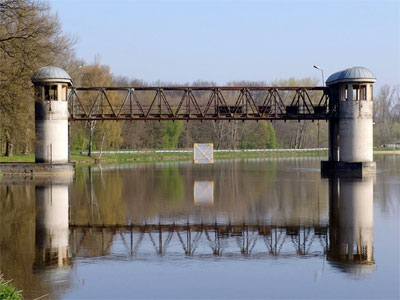
Photography courtesy of H3T Architects (Click images to enlarge)


Suspended above the river Elbe, a simple wooden cube hangs from an abandoned bridge. The structure, executed by H3T architects, was crafted hastily from cheap and recycled materials, but this cube is not intended to remain intact for more than a couple of weeks. While it stands, visitors are encouraged to gather firewood from the surrounding wilderness, hoist themselves through a trap door accessible only by boat, and enjoy the pleasures of an aerial sauna.
Called the Flying Sauna, H3T warns potential visitors to proceed with caution when attempting to use it, noting that the underlying river’s current is strong. Indeed, the bridge that it hangs from marks the site of a weir that was dismantled during the mid-1970s. The sauna is meant to serve as a way of calling attention to the abandoned structure.
The Flying Sauna is the Czech studio’s second public sauna project. In 2009, H3T erected Sauna on the Water, a four-day construction project that produced a floating steel and plywood cube with a cast iron stove installed for heat. H3T advises using the saunas by moonlight in order to emphasize the contrast between the “beautiful lantern light” and the glistening lake. Both projects are a certainly a far cry from the glossy, tiled saunas that accompany many modern gyms and swimming pools. Instead, the humble cubes are reminiscent of traditional saunas that interact with their natural settings, whether they were burrowed into an earthen pit or built entirely from stone and wood. By reclaiming the origins of the sauna, H3T has managed to celebrate the natural and the manmade simultaneously.
(more…)
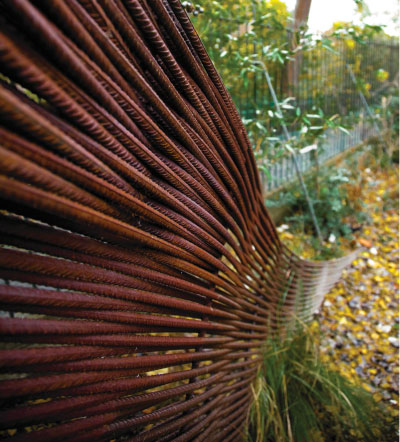
Photography by Dan Farrar. Additional photography by Groves-Raines Architects. (Click images to enlarge)

One mile north of Edinburgh’s city center, a composting shed has garnered a great deal of international attention. Boasting two Scottish Design Awards and an Excellence in Design Award from the American Institute of Architects, the seven-month construction project was conceived and executed by Scotland’s Groves-Raines Architects. Made from Corten steel and rebar — the steel used in reinforced concrete — the shed has the potential to strike a jarring contrast with the surrounding greenery. Yet the industrial materials are manipulated with traditional techniques, creating a structure that emerges strikingly naturally from its surroundings.
Because the rods that make up the shed are inserted directly into the ground, the garden remains unaffected by any invasive building foundations. To create the dual-purpose composting shed and garden store, the architects relied on “a technique similar to traditional willow weaving” to make the steely walls more conducive to its earthy setting. Bent into smooth curves, the rods lose much of the harsh quality often associated with industrial building materials and begin to blend seamlessly with the adjacent wooded area. The woven rods allow air and light to stream into the shed, a benefit both practical and aesthetic. Lastly, the roof is made with weather-resistant EPDM lined steel and planted with grass, reinforcing “the connection with the wooded context” that the architects rightfully claim. By re-purposing the typical building blocks of urban architecture to create an “organic form” structure, Groves-Raines Architects successfully reimagines our uses for man-made materials.
(more…)
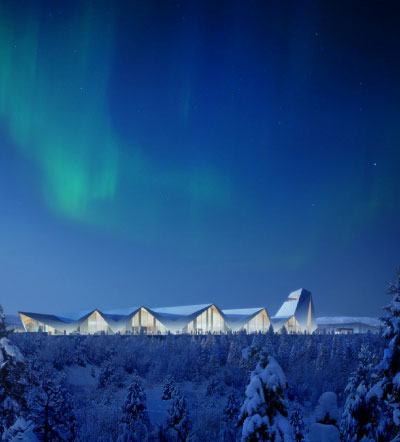
Photography courtesy of Imaging Atelier. (Click images to enlarge)

When an Oslo-based architectural firm committed to “boldness” and “innovation” joins creative forces with the “international outlook” of a young London firm, it seems likely that their collaborative efforts will favor universal appeal over landscape-specific subtlety. Judging by the concept sketches and feasibility report presented by Narud Stokke Wiig Architects and Planners and Haptic, however, the firm’s proposed design for a Norwegian international airport located just below the Arctic Circle manages to fit both criteria.
Avoiding the harsh juxtaposition of a thoroughly modern structure against the backdrop of an otherwise remote and forested region, NSW and Haptic have instead molded their sharp lines to mimic the local terrain. Shoving the terminal building’s roof into a series of jagged peaks, the design pays homage to the nearby mountains of Traena, with a control tower enclosed within the structure’s tallest peak.
The Nordland, Norway airport certainly isn’t the first of its kind to take inspiration from the surrounding landscape. Yet similar structures like the Denver International Airport, known for its peaked white tensile fiberglass roof reminiscent of the Rocky Mountains, supplement their visual tribute to the environment with sustainable design and environmentally sound materials. Since 2008, DIA has vastly reduced its annual carbon emissions with a massive on-site solar energy system.
(more…)
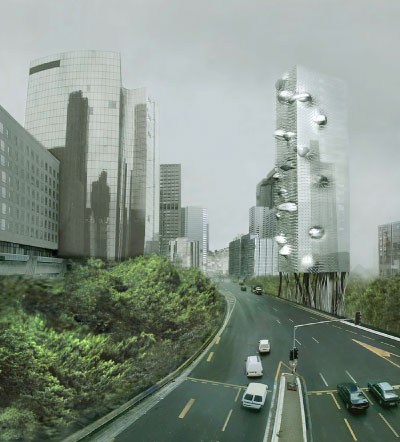
(un)plug, design for an office tower in Paris

Green thinking is changing the way we build. We’re reusing existing structures and materials, designing more efficient building systems, and thinking about long-term sustainability. But these changes are minor in view of the far deeper changes to come, as ecologically-minded designers reexamine their most fundamental assumptions about a door and a roof and a foundation, and reimagine what a building is entirely.
The visionary French architecture office R&Sie(n) is right at the forefront. Its projects, collected in the book Bioreboot: The Architecture of R&Sie(n), offer an architecture that’s deeply enmeshed with natural forces, and entirely liberated from modern conventions about design and construction.
Since the mid-nineteenth century, when steel framing supplanted heavy masonry construction, buildings have been conceived as stable shells that shaped efficient interior environments, as machines for living. R&Sie(n) complicates this paradigm. Its buildings aren’t discrete, unchanging objects but mutable devices embedded within ecologies of weather, time, geology, flora, and fauna.
(more…)
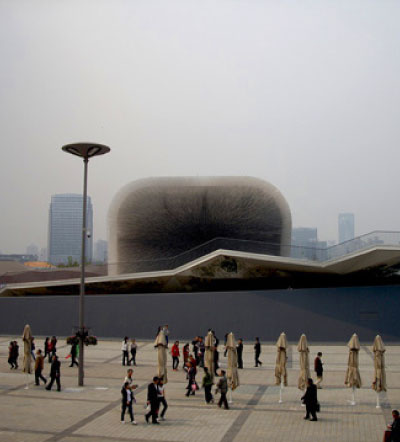
UK Pavilion at Shanghai Expo 2010. Photography by Chaz Hutton. All photography via Dezeen

We did a piece last year on mockups for the international pavilions slated for this year’s World Expo. Now that they are actually all built and the expo is officially open, we wanted to show you how some of the finished structures turned out.
All images courtesy of Dezeen
(more…)

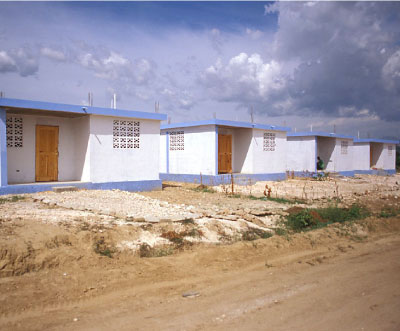
A Core House for Haiti, by Habitat for Humanity


The numbers are numbing. The January 12 earthquake in Haiti left approximately 1.2 million people homeless, 600,000 of them in the capital city of Port-au-Prince. As the rain and hurricane season begins this month many are still living in shelters constructed from scrap wood and tarps, in informal settlements without adequate power and sanitation.
While the Haitian government oversees long-term redevelopment, private and non-governmental agencies (NGO’s) are taking the lead to provide housing. Some are focusing on overarching strategic work, using their expertise to support other organizations. Architecture for Humanity has developed open-source guidelines for rebuilding, established Community Resource Centers to support NGO builders in the field, and is planning to rebuild schools. The San Francisco based organization Build Change has established simple technical standards for earthquake-resistant construction to guide local and NGO builders.
Many NGO’s are working directly to put up housing. The initial drive is to provide temporary shelters so that people can survive the hurricane season. Teams are searching for quick and economical solutions to help the greatest number of people. Habitat for Humanity began its relief work by distributing thousands of emergency kits packed with twine and tarps to the country. A Home in Haiti, an Atlanta organization that ships camping tents purchased by individual donors directly to the country, has intensified its outreach in recent weeks to beat the impending storms.
(more…)
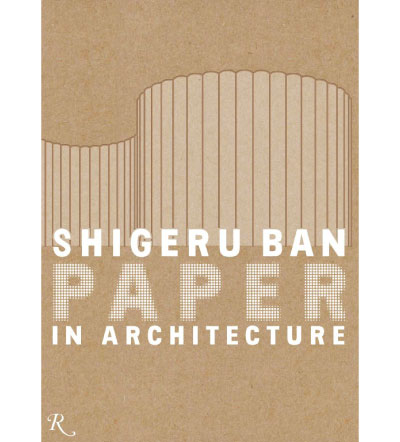
All images courtesy of Rizzoli, from Shigeru Ban: Paper in Architecture

There are great architects who work with established conventions, elevating them masterfully. And there are great architects who work without regard to conventions, establishing their own way of building. Shigeru Ban is this kind of architect. His innovative structures employ industrial cardboard tubes as structural framing elements. Collected in last year’s book Shigeru Ban: Paper in Architecture, these projects seem especially meaningful right now, as we rebuild after earthquakes in Haiti and Chile and search for an architecture that’s practical, inexpensive, and beautiful.
Like Frank Gehry houses of exposed wood studs and plywood, and Tadao Ando’s buildings in poured concrete, Ban’s structures take an everyday building material and transform it with ingenuity and grace. Ban has studied these tubes for decades, working closely with engineers and lawmakers in Japan to establish standard construction methods, details, and metrics. He single-handedly advanced their technology and developed their vocabulary, one that’s on the verge of a new kind of architecture.
(more…)
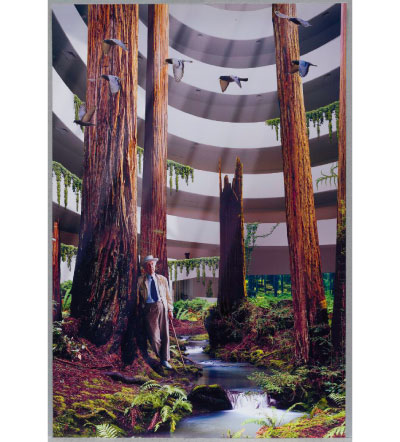
Saunders Architecture, FLW in His Element, 2009 All images courtesy Guggenheim Museum.

In conjunction with its 50th anniversary the Guggenheim Museum sponsored a design challenge, inviting almost 200 artists, designers, and architects to propose treatments for the signature spiraling atrium of its Frank Lloyd Wright building. The collection of proposals, Contemplating the Void: Interventions in the Guggenheim Museum, is on view now through April 28, and also posted on the museum’s website. The show offers a compelling snapshot of contemporary design currents, particularly of green building strategies.
The entries, and the media in which they’re presented, are impressively diverse. There are crayon drawings, watercolors, and pencil sketches, laser-cut models and computer renderings. The most straightforward proposals place one object within the building’s enormous central space. Different designers propose a chandelier, a hot air balloon, a column of water, a cloud of pigment, an oil rig, and the body of an Airbus A380. The more tectonic proposals, which respond to the space’s forms and circulation, are less inspired. Many designers install mirrors to distort perceptions of the space, build interconnecting passages within the space, and extend the existing curving ramp upwards, downwards, and outside the shell of the building.
(more…)
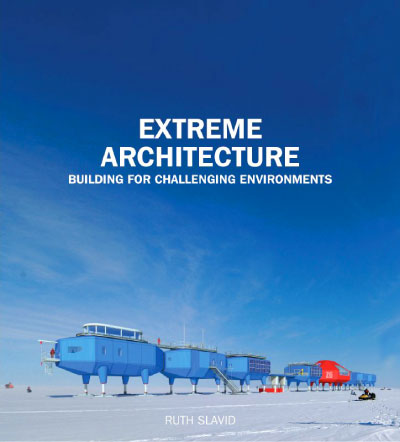
Published by Laurence King.

Here’s a book from last year that slipped under our radar: Extreme Architecture: Building for Challenging Environments, by Ruth Slavid. It’s a compilation of contemporary structures that were designed in response to extraordinary environmental conditions (heat, cold, water, altitude, and outer space) and less directly in response to aesthetics.
Some of the projects, such as a ski jump by Zaha Hadid and a spa by Mario Botta, are self-consciously avant-garde and others, such as snow sheds and desert schools, are fundamentally utilitarian. Yet all, as they turn to meet the challenges of the environment, unsettle expectations of what a building should look like. They don’t simply fall into fashion.
Rather than sit upright on the ground, as conventional buildings do, those in hot and windswept climates tend to burrow beneath it, and those in wet and high climates tend to leap away from it. The buildings are similarly polarized in appearance, evoking either prehistoric or futuristic styles. A hotel in Patagonia, finished in roughly hewn wood and sunk into the earth, resembles a neolithic ruin. A giant drum-shaped workstation in Antarctica, hovering on squat steel legs, looks like a science fiction stage set. Many of the structures have an animated quality, as if they’re creatures who’ve undergone evolutionary mutations and adaptations. A cultural center in British Columbia, Canada lies camouflaged within the scrubby landscape. A ski jump in the Alps lifts its head above adjacent peaks like a brontosaurus.
(more…)
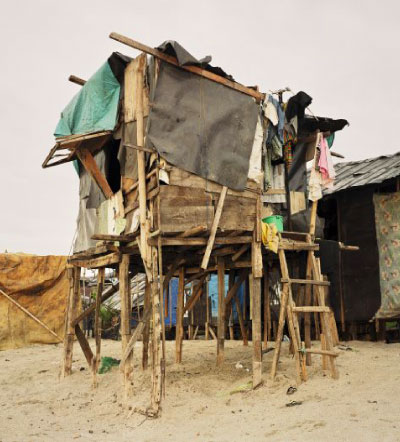
All Photography by Peter Bialobrzeski, courtesy of Hatje Cantz.

Peter Bialobrzeski’s photographs of houses in the informal community of Baseco, Manila, might be especially relevant right now. The small, tilting, wood-framed homes in these pictures, sealed with scraps of fabric, plastic tarps, and posters, are vivid expressions of vulnerability and determination. They remind one of the emergency conditions in Haiti, where thousands of people are currently living in similarly constructed makeshift shelters and, because of cyclical poverty and challenges in rebuilding, could remain indefinitely.
The collection’s title, “Case Study Homes”, refers ironically to the Los Angeles Case Study Houses of the 1950s, a series of modernist prototypes documented in coolly glamorous photographs by Julius Schulman. Bialobrzeski’s photographs don’t have that gloss, of course, but they possess a stately formal beauty that confers dignity on the houses. A diffuse tropical light mutes vivid colors and shadows to give the images a silvery, etched appearance, like Walker Evans’ Depression-era photos. While Evans looked straight into his subject’s faces, however, Bialobrzeski only examines the outside of their homes, a strategy that steers clear of sentimentality. These photographs give straightforward testimony.
(more…)







 Facebook
Facebook Permalink
Permalink Digg
Digg Reddit
Reddit LinkedIn
LinkedIn StumbleUpon
StumbleUpon Tumblr
Tumblr











